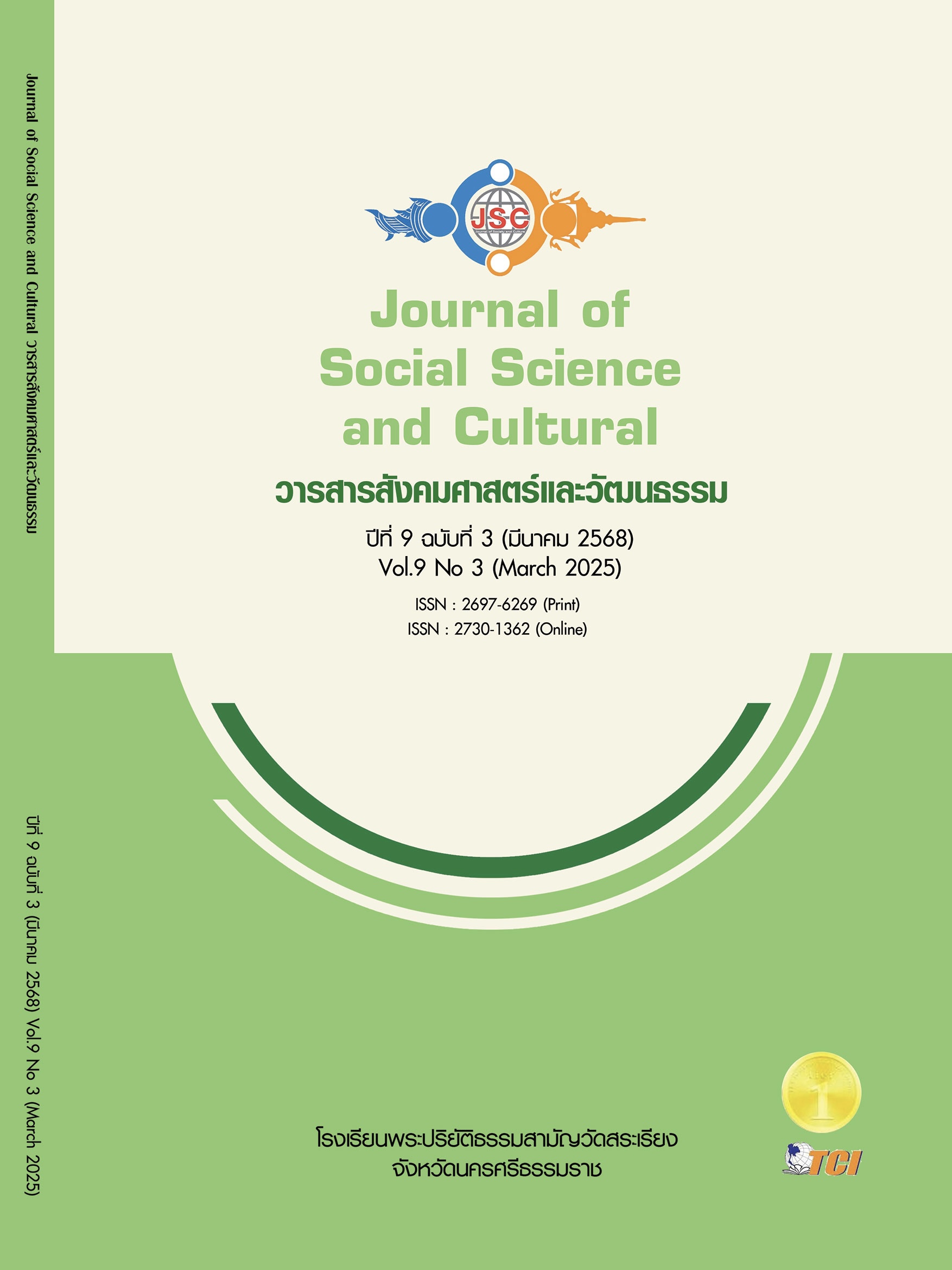A STUDY OF ROLES OF SACRED WATER FROM “TWELVE LEGENDS” PARITTA CHANTING
Main Article Content
Abstract
This research article aims to study the relationship between the roles of sacred water derived from the chanting of the 12 legends of the Paritta (protective Buddhist chants) and its use for various social purposes in contemporary Thai society, using a framework based on the concept of functionalism. In this study, the researcher refers to the sacred water derived from chanting the 12 legends of the Paritta as “Paritta Sacred Water.” This is a qualitative research study where the researcher gathered relevant data from three sources: 1. Primary documents: These include the Tripitaka scriptures and translated commentaries, such as the *Suttanta Pitaka* (Sermon Section) of the *Khuddaka Nikaya* and the *Dhammapada* (Dharmic Verses) edition from Mahamakut Rajavidyalaya University 2. Secondary documents: These include research studies, articles, and books that are related to the role of holy water from chanting the 12 Paritta legends, as well as content related to the Paritta chants themselves 3. Online media: These include contemporary references on how Paritta sacred water is made, associated beliefs, and discussions about the 12 Paritta legends. The researcher collected and analyzed these data between May 2024 and December 2024, over a period of seven months. The findings of the research show that the roles of sacred water derived from chanting the 12 Paritta legends reflects two significant social roles which are 1) The role of sacred water as a sacred object that enhances auspiciousness for its holder and 2) The continued presence of traditional sacred water rituals in contemporary society. It emphasizes the importance of Buddhism that Buddhism as an anchor for the minds of people in Thai society.
Article Details
References
ธนิต อยู่โพธิ์. (2517). ที่ระลึกงานพระราชทานเพลิงศพนางเยื่อ มุสิกาภูมิ. กรุงเทพมหานคร: สำนักพิมพ์ธรรมเมธี.
พระครูโอภาสธรรมพิทักษ์ (เสียม เตชธมฺโม). (2559). พัฒนาการรูปแบบการสวดมนต์ในสังคมไทยปัจจุบัน. วารสาร มจร พุทธปัญญาปริทรรศน์, 1(1), 23-36.
พระธรรมกิตติวงศ์ (ทองดี สุรเตโช). (2553). พจนานุกรมเพื่อการศึกษาพุทธศาสน์ “คำวัด”. กรุงเทพมหานคร: ธรรมสภาและสถาบันบันลือธรรม.
พระพิษณุพล สุวณฺณรูโป(รูปทอง). (2559). การศึกษาวิเคราะห์พระปริตต์ในพระพุทธศาสนา. ใน สารนิพนธ์พุทธศาสตรดุษฎีบัณฑิต สาขาวิชาพระพุทธศาสนา. มหาวิทยาลัยมหาจุฬาลงกรณราชวิทยาลัย.
พระมหาประทีป สญฺญโม (พรมสิทธิ์) และโสวิทย์ บำรุงภักดิ์. (2560). การศึกษาการบำบัดโรคด้วยการเจริญพระพุทธมนต์ในเชิงพัฒนาการ. วารสารวิชาการธรรมทรรศน์, 17(3), 403-414.
พระอธิการศิริศักดิ์ ยสินฺธโร (ล้ำเลิศ). (2565). ศึกษาวิเคราะห์คุณค่าจุลราชปริตรในพระพุทธศาสนาเถรวาทที่มีต่อสังคมไทย. ใน วิทยานิพนธ์พุทธศาสตรมหาบัณฑิต สาขาวิชาพระพุทธศาสนา. มหาวิทยาลัยมหาจุฬาลงกรณราชวิทยาลัย.
ศักดิ์สิทธิ์ พันธุ์สัทธ์. (2565). บทสวด 7 ตำนาน 12 ตำนาน และความเป็นมา. เรียกใช้เมื่อ 30 กรกฎาคม 2567 จาก https://www.lcbp.co.th/บทความสาระทั่วไป/บทสวด-7-ตำนาน-12-ตำนาน-และควา/
ศิริพร ณ ถลาง. (2557). ทฤษฎีคติชนวิทยา: วิธีวิทยาในการวิเคราะห์ตำนาน - นิทานพื้นบ้าน. กรุงเทพมหานคร: สำนักพิมพ์แห่งจุฬาลงกรณ์มหาวิทยาลัย.
สมเด็จพระพุทธโฆษาจารย์ (ป.อ.ปยุต̣โต). (2561). พจนานุกรมพุทธศาสน์ ฉบับประมวลศัพท์. กรุงเทพมหานคร: มูลนิธิพุทธธรรม.
สุชาติ บุษย์ชญานนท์. (2561). ความเชื่อเรื่องน้ำมนต์สำหรับพุทธศาสนิกชน. วารสารวนัมฎองแหรกพุทธศาสตรปริทรรศน์, 5(1), 25-39.

